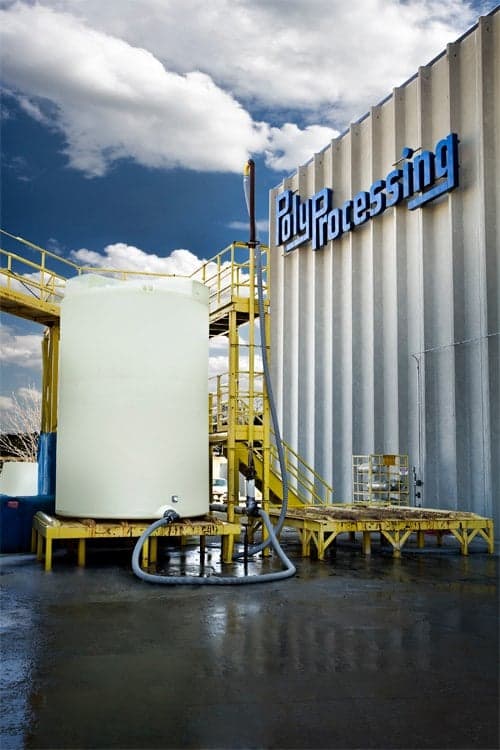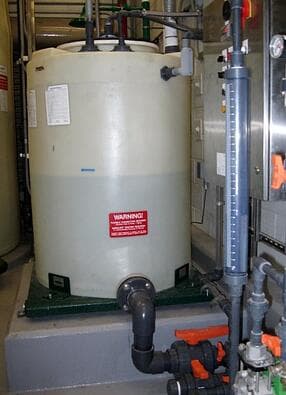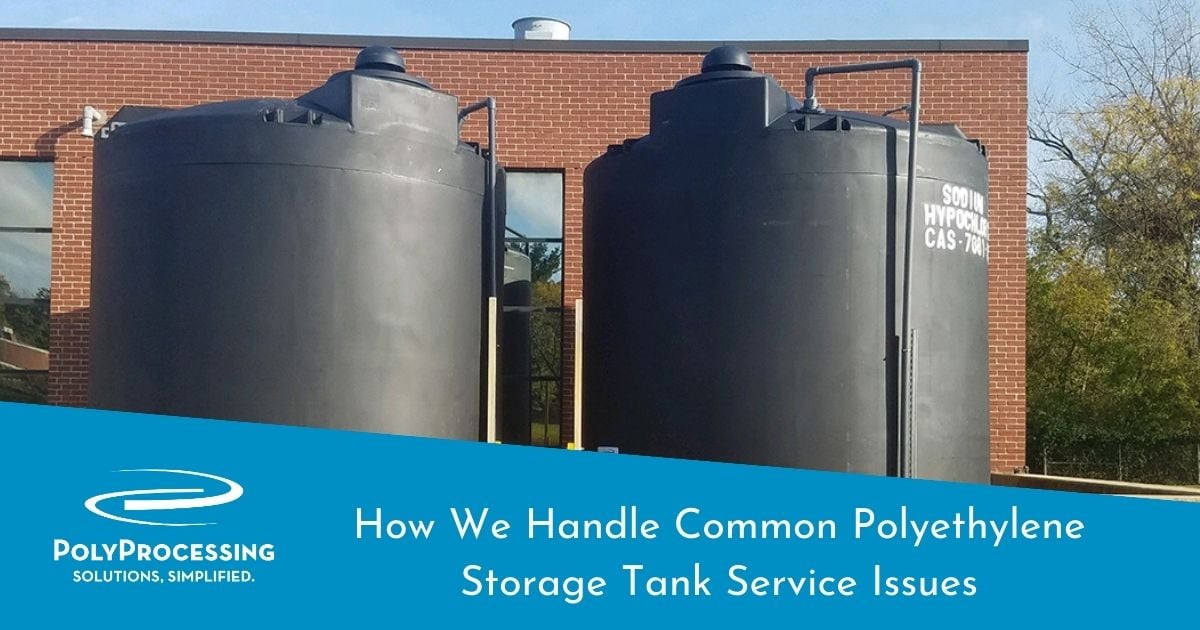How We Handle Common Polyethylene Storage Tank Service Issues
When you have questions about chemical storage or concerns about your chemical storage tank system, you want quick answers. You want to know who to call and get a live voice without getting the runaround. A solid customer service team takes great pride in delivering service that saves you time and eliminates any hassles.
Typical Customer Service Inquiries

Customer service is the first line of contact for all customer related calls. Some of the most frequent questions our customer service representatives receive are related to basic chemical storage. Customers or prospects often call asking about how to store a specific chemical - such as sulfuric acid or sodium hypochlorite.
The chemical tank storage solution always begins with building around the challenges and potential hazards of storing a specific chemical. The type of chemical, location, and other usage factors determine the best and safest solutions to many storage tank system requirements.
Other frequent customer service questions deal with conducting tank inspections. When we receive these types of calls, customer service provides the information needed to conduct a tank inspection or arranges for a Poly Processing field technician tank inspection.
At PPC we see 5 common mistakes that occur at the time of installation. Learn more about these five mistakes so that you can be prepared before you install a polyethylene chemical storage tank.
Poor Venting
 Proper venting is a critical aspect of safe chemical storage. Our field service team in many cases discover that customers have reduced the vent size or underestimated the needed vent capacity.
Proper venting is a critical aspect of safe chemical storage. Our field service team in many cases discover that customers have reduced the vent size or underestimated the needed vent capacity.
A modified vent may create less than adequate CFM throughput. Inadequate venting not only increases the risk of a hazard, but the tank in many cases may no longer be under warranty due to venting guidelines and/or not meeting the venting requirements for the tank size and application.
In order to avoid the costly problems of an improper venting system, we’ll work with you before we manufacture and assemble your tank system. This will ensure that your tank’s engineering is right the first time. It may cost a little more up front, but it will save money in the long run—and you won’t have to deal with environmental, health, and safety compliance issues down the road.
No Flexibility
Because of the nature of polyethylene to expand and contract, we require flexible connections at the bottom ⅓ of the sidewall on many Poly Processing tanks. If proper flexible connections aren’t installed, any kind of movement of the tank can put harmful stress on the plumbing and cause a break or breach to peripheral plumbing and in worse case scenarios the rigid plumbing could ultimately crack the tank, leading to a more hazardous situation.. This is especially critical in regions that are susceptible to earthquakes, and tanks that could get moved or bumped by heavy equipment.
 Some customers choose not to install flexible connections upfront because they see a flexible connection as creating more opportunities for a leak. However, incorporating the flexible connection at the beginning eliminates this risk through its expansion and contraction and allows the tank to expand freely and securely.
Some customers choose not to install flexible connections upfront because they see a flexible connection as creating more opportunities for a leak. However, incorporating the flexible connection at the beginning eliminates this risk through its expansion and contraction and allows the tank to expand freely and securely.
Other customers hire contractors to install the connections and the contractor fails to use flexible connections. Or, for situations where a flexible connection is used, the pipes aren’t aligned correctly and the flexibility is maxed out at installation which in turn does not allow the flex connection to perform as intended.
Don’t skimp on this requirement. Flexible connections are a necessity to ensure your chemical tank system maintains its integrity.
Inaccessible Tanks
All too often we see tanks that are installed in buildings with very little planning. When a tank is at the end of its useful life, you’ll need to be able to access it and remove it from the building. More importantly, you’ll need to be able to install a new tank in its place. If the old tank is entombed it can be cut up and removed, but the new tank must be installed as a whole.
End use customers have had to remove building roofs and outer walls in order to install new tanks because the customer never planned for tank replacement. When this happens, the additional cost of removing parts of your facility’s structure can add up.(i.e. labor, machinery, downtime, etc.)
It’s important to consider the tank size you will need during the construction of your facility. This will prevent you from having to remove a wall or part of the roof during installation and removal.
Before you order your tank, think through questions such as these:
- What size tank(s) will I need?
- Will the tank be close enough to a doorway so that it can be easily taken out and replaced?
- Is it far enough away from other tanks to allow the equipment to remove the old tank?
- Will any plumbing or other fixtures make it difficult to access the tank?

Inadequate IMFO® Support
As a best practice, we recommend using our Installation, Operation, and Maintenance Manual to reference at all times. This is especially important when your chemical storage tank has an IMFO fitting molded as part of it. While the fitting itself is molded as an integral part of the tank and assembled at our plant site, it is critical that the IMFO neck and its piping be properly supported at all times.
When plumbing to the IMFO, make sure all valves and piping are supported by the ground or by other means - not by the IMFO fitting or the tank. Improper support could put pressure on the fitting or the tank, risking your operation, chemical, and employee safety.
Improper Torque on Fittings
When we deliver a tank, we ask the customer to retorque all of the fittings to the Installation and Operation Guide standards and hydro test the tank for a minimum of 24 hours by first filling it with water. This ensures that there are no leaking fittings before a hazardous chemical fills the tank. Unfortunately, this doesn’t always happen and customers may immediately add the chemical they purchased the tank to store. Fittings can loosen up during transportation and installation which would cause the chemical to leak from the tank and create an immediate problem or hazard to resolve.
Be sure you know the proper torque for your tank’s fittings, and don’t take shortcuts. Follow the torquing procedure in the Poly Processing Installation Guide to prevent costly mistakes.
To maintain safe storage of chemicals and proactively detect cracks, weak seams and fittings, and other storage tank stress points that could develop into potential leaks or spills, a comprehensive annual chemical storage tank maintenance inspection is strongly recommended. Even if the polyethylene tank is relatively new, a routine maintenance schedule and proper maintenance checklist and careful visual inspection of the chemical tanks is suggested.
Here is an annual tank inspection checklist. Follow these steps and conduct a storage tank inspection on a regular basis at least annually to ensure the safety of personnel, properly functioning tank system, and the preservation of the chemical stored. When performing routine maintenance, indications or signs of stress cracking, crazing, or embrittlement are discovered, the chemical storage tank may need to be replaced.
Annual Chemical Storage Tank Inspection Checklist
- First of all, empty the storage tank. Any chemicals remaining must be neutralized. The outside and inside of the tank must be completely and thoroughly cleaned. It’s impossible to properly inspect a dirty tank.
- Cracking, crazing and brittle appearance are the first indications of tank leaks. Examine the tank to pinpoint these signs.
- The areas around fittings and where different portions of the tank converge into one another are the area of storage tanks that typically show signs of weakness. Pay close attention to these areas of the tank in your inspection. For instance, closely examine the tank “corners” where sidewall and dome of the storage tank meet and where sidewall and bottom meet.
- Inspecting the interior of the storage tank is crucial because cracks typically start on the inside of the tank initially. Inspecting the inside of the tank is always challenging since it’s usually not possible to physically enter the inside of the storage tank. Use a high powered, bright light to thoroughly examine the inside of the tank from the manway opening.
- The dome of a chemical storage tank can become brittle from chemical fume exposure. Because the tank vent emits chemical fumes, oxidation can occur. Carefully inspect the dome and all areas of the tank that do not come in direct contact with chemicals but are exposed to fumes and potential oxidation breakdown.
- Fittings, hoses, gaskets, and all connections. All storage tank fittings, flexible connection hoses, and gaskets must be carefully inspected to detect any signs of general corrosion or deterioration and leaks. Any defective fitting, hose, or gasket must be replaced immediately.
- Adequate venting for pressure and vacuum is essential in all chemical storage tanks. Check the vents and scrubber piping and make sure they are functioning properly. Ensure end of scrubber piping is never submerged in more than 6 inches of liquid.
- Confirm that filling of the tank from tanker trucks is not causing over pressurization and not ending with a line purge that “balloons” the tank. Please refer to this article for proper chemical storage tank venting.
- Is the secondary containment of the chemical storage tank appropriate for chemical stored, adequate in size, and in good condition? In the event of a leak or spill, will the secondary containment function to minimize the risk of contamination?
It’s important to conduct a poly tank inspection to prevent injury and property damage from leaks and spills of chemicals. These nine steps follow the basic annual chemical storage tank checklist. Please refer to the annual tank inspection checklist for a printable, checklist copy to document the inspection and for vital storage tank inspection warnings.
If you have a chemical storage question, or problem with an existing tank, download our IOM Manual here or contact a chemical storage tank specialist on our customer service team.
- February 20, 2023
- Topics: Value Added
About Poly Processing
Posts By Topic
Tech Talk Podcast Episodes
Subscribe By Email
Recent Posts
- Maximizing Fill Efficiency: Selecting the Optimal Fill Line System
- Chemical Storage Tanks: A Quick Guide for End Users
- Popular Customization Options for Chemical Storage Tanks
- Understanding Flood Zones Under the IBC: Building Requirements and Insurance Implications
- Choosing Between Steel, Polyethylene, and Fiberglass Tanks: What You Need to Know
Tank Configurator

Find the recommended tank and system components for your chemical storage challenge.
Configure a Tank Package




